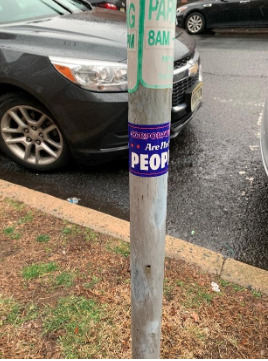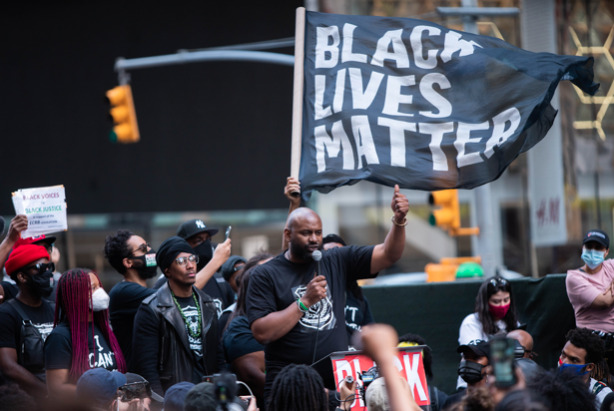Beyond social distancing and DIY haircuts, a fed-up nation may no longer be willing to tolerate unbridled corruption and complacency
As faith in our journalists reaches an all-time low, the post-truth information age is marked by a polarized media and the new norm of fake news. All the while, the global pandemic of COVID-19 has wreaked havoc on the United States and has made the cracks in the unsustainable status quo glaring and evident. As tens of millions of Americans file for unemployment and daily death counts soar beyond those of 9/11, billionaires churn a profit from their time in quarantine and economists ask if the lives of the elderly are really worth more than the state of our economy. As medical students graduate bearing hundreds of thousands of dollars of student debt get booted to the frontlines in a last-ditch effort to prop up America’s failed healthcare system, corporations are quick to shower essential workers with praise and platitudes, but silent when it comes to providing them with appropriate hazard pay or protective equipment. While angry white men toting assault rifles storm the Michigan capitol to scream at the governor, African Americans protesting the murder of George Floyd are teargassed and brutalized by the police.
The “new normal” of our country is not just social distancing or DIY haircuts, but perhaps a fed-up nation that will no longer tolerate blatant corruption and complacency.
How culture jamming supports the call for action
This is where culture jamming—a tactic used by anti-consumerist social movements to subvert and disrupt corporate messages and consumer culture—comes in. If you ever threw away an unwanted flyer without a glance, or slammed your fist on the “Skip ad in 5 minutes” button of a YouTube ad, then you know what it’s like to feel fed up with the onslaught of ads that creep into every aspect of modern life. And, just maybe, you’ve acted on one of these experiences—have been prompted to leave a scathing comment on social media, to share a sardonic brand-bashing meme, or have added your electronic signature to a petition to boycott a company.

While there remains considerable debate among scholars over the effectiveness of these personal, online-centric actions—also known as “participatory civics”—culture jamming, which challenges and disrupts the political and economic status quo, proves such acts are not necessarily mere slacktivism.
In his 1999 essay “The Revolutionary Impulse,” Activist Kalle Lasn describes culture jammers as a “loose global network of artists, activists, environmentalists, Green entrepreneurs, media-literacy teachers, downshifters, reborn Lefties, high-school shit disturbers…[that] cover the spectrum from the cool intellectual middle to the violent lunatic fringe.” Whether it’s a ‘liberated’ billboard sporting a new makeover of graffiti, or an article simply aiming to inform readers — culture jamming boils down to a shared spirit of belligerent resistance towards the hegemonies of consumer culture and consumerism. But regardless of its form, culture jamming aims to expose the ubiquitous messages advocated by corporations and mainstream media for what they truly are: grandiose and empty-handed promises of happiness and fulfillment brought by shallow excess and extravagant consumption.
The Situationists and the spectacle

Although the term “culture jamming” was first coined in 1984 by the late musician and radio DJ Don Joyce (after the practice of radio jamming – the deliberate disruption of radio signals), the practice can be traced back to at least 1957. Then, a group of European intellectuals and avant-garde artists noticed how consumer capitalism “ha[d] weakened the creativity of everyday people” (Lasn, 1999, p. 100), and in response to this sinister new foe, formed the first known culture jamming organization—the Situationist International. The Situationists spoke of how a “spectacular” phenomenon of commodity consumption and hype—aptly named the “spectacle”—behaves as an instrument of social control, replacing the spontaneity and creativity of authentic living in favor of “prepackaged experiences and media-created events” (Lasn, 1999, p. 101). Propagated by late-stage capitalism and normalized by consumer culture, the “society of spectacle” the Situationists warned about now reigns supreme. While companies like Apple illegally sabotage and throttle their own products so they may become obsolete in less than a year, Disney attempts to monopolize culture by contorting anti-trust legislation, and the price of a drink at Starbucks is now nearly as much as the cup’s fluid ounces. In frenzies to grab the discounts, shoppers stampede and kill retail employees every Black Friday to acquire more products (the day after supposedly feeling thankful for what they have), and super-brand conglomerates have silently surfaced under neoliberalism, undetected by much of the public. While corporations produce disingenuous commercials that pretend to take moral stances on social issues such as gender equality or the environment, they commit widespread labor abuses, violently suppress workers’ attempts to unionize, and ravage rainforests.
Challenging corporate cultural domination
We are socialized to welcome — no, to wholeheartedly embrace — the spectacle of consumer capitalism. From early childhood, Americans learn to conflate the significance of holidays with expensive toys, remedy our sadness with shopping sprees, and live for the next vacation as a “sanity-saver” (Lasn, 1999, 104) all coming together to perpetuate, not alleviate, the sense of vacancy, alienation and lack of fulfillment that so many of us feel in our lives. Here, culture jammers come in yet again. Lasn claims that, at its root, culture jamming is a “metaphor for stopping the flow of spectacle long enough…to se[e] hell in the world you thought was heaven” (Lasn, 1999, 107). The paradox of the spectacle lies in how it subdues the masses so they will not challenge it. If the omnipresence of consumer culture has numbed the American public into submission, then the culture jammer’s job is to shock and wake them from this media-induced trance. The end game of the culture jammer, however, is not to simply get attention, but ultimately, to mobilize the public into challenging the corporate domination of our society, and hopefully, to vanquish it.
Until then, we will all suffer together inside this stratified regime, where its constituents are not people but corporations, and where people are no longer people but consumers, and “being is having” (Lasn, 1999, p.102).
While the Situationist International lasted just a decade, the spirit of its tenets lives on, and inspires new generations of activists. And perhaps now, in the midst of the coronavirus, this core belief of the Situationists is particularly relevant:
“Many times a day, each of us comes to a little fork in the path. We can then do one of two things: act the way we normally, reflexively act, or do something a little risky and wild, but genuine…Living well [requires] the systematic questioning of all the diversions and works of a society, a total critique of its idea of happiness.” (Lasn, 1999, pp.101-103)

Inside the new normal, and in the wake of the wave of protests against police killings of many unarmed Black Americans, there is still potential for good to come out of these calamities—such as achieving universal basic income, universal healthcare, systematic overhauls to the criminal justice system and firmer worker safety nets.
Like any other social movement, progressive strides will never be easily granted, but can be obtained after tooth-and-nail fights in grim and exceedingly difficult conditions (Massey, 2004, p. 183). No matter how trivial things may seem, it’s important to remember how this is always how bigger and more meaningful things start— lest we forget how an elderly seamstress too tired to stand jump started the civil rights movement, or how 12-year-old Canadian Craig Kielburger launched a movement that would save millions of children from labor exploitation. As the anthropologist Margaret Mead once said: “Never doubt that a small group of thoughtful, committed citizens can change the world; indeed, it’s the only thing that ever has.”
Sources
Adbusters Media Foundation: Journal of the Mental Environment. (n.d.). Retrieved May 11, 2020, from https://www.adbusters.org/
Ahmaud Arbery Is Chased and Killed in “Self-Defense,” 8 Years After Trayvon Martin. (2020, May 08). Retrieved May 11, 2020, from https://eji.org/news/eight-years-after-trayvon-martin-another-young-black-man-is-chased-and-killed-in-self-defense/
Anonymous Group Official Website. (n.d.). Retrieved May 11, 2020, from http://www.anonymoushackers.net/
Desjardins, J. (2016). The Illusion of Choice In Consumer Brands [Digital image]. Retrieved May 11, 2020, from https://www.visualcapitalist.com/wp-content/uploads/2016/07/consumer-brands-full-size.html
Firestone, D. (1993, December 31). While Barbie Talks Tough, G. I. Joe Goes Shopping. Retrieved May 11, 2020, from https://www.nytimes.com/1993/12/31/us/while-barbie-talks-tough-g-i-joe-goes-shopping.html
Heinz, B. (2019, October 01). It’s Time to Break Up Disney. Retrieved May 11, 2020, from https://prospect.org/power/time-to-break-up-disney-monopoly/
Heinz, B. (2019, October 30). How the Disney Monopoly Influences What You Can See. Retrieved May 11, 2020, from https://prospect.org/power/how-the-disney-monopoly-influences-what-you-can-see/
Iman Naderi, Eric Van Steenburg, (2018) “Me first, then the environment: young Millennials as green consumers”, Young Consumers, https://doi.org/10.1108/YC-08-2017-00722.
Kaplan, M. (2019, November 26). Black Friday’s most gruesome injuries and deaths through the years. Retrieved May 11, 2020, from https://nypost.com/2019/11/26/black-fridays-most-gruesome-injuries-and-deaths-through-the-years/
Kelly, J. (2020, April 26). Billionaires Are Getting Richer During The COVID-19 Pandemic While Most Americans Suffer. Retrieved May 11, 2020, from https://www.forbes.com/sites/jackkelly/2020/04/27/billionaires-are-getting-richer-during-the-covid-19-pandemic-while-most-americans-suffer/
Kirby, J. (2017, December 22). Apple admitted it’s slowing down certain iPhones. Retrieved May 11, 2020, from https://www.vox.com/2017/12/22/16807056/apple-slow-iphone-batteries
Lasn, K. (2000). The Revolutionary Impulse. In Culture jam: How to reverse America’s suicidal consumer binge, and why we must (pp. 100-136). New York: Quill.
Massey, G. (2012). Ways of Social Change. New York: Sage.
Poster Boy. (2014, September 07). Retrieved May 11, 2020, from http://www.isupportstreetart.com/artist/poster-boy/
S. (n.d.). Statue of Liberty with Us [Digital image]. Retrieved May 11, 2020, from https://ak.picdn.net/shutterstock/videos/479911/thumb/1.jpg
Stewart, E. (2020, February 25). Corporate monopolies are hiding in your grocery aisle. Retrieved May 11, 2020, from https://www.vox.com/2020/2/25/21147280/illusion-of-choice-monopolies-brands-sarah-miller
Trinko, K. (2018, May 03). Gen Z is the loneliest generation, and it’s not just because of social media. Retrieved May 11, 2020, from https://www.usatoday.com/story/opinion/2018/05/03/gen-z-loneliest-generation-social-media-personal-interactions-column/574701002/


